Authentic education: More recent times
Almost from the moment it was applied to mass, institutionalised schooling, didactic education attracted its share of critics, from popular culture (the image of the stern school teacher) to the ranks of the education profession itself. ‘Progressivists’ began to ask questions such as, ‘Isn’t there more to knowledge than the “black-and-white” rigidity of right and wrong answers?’ ‘What is the moral lesson of teaching that requires the passive acceptance of received knowledge on the assumption that it is unquestionably correct?’ ‘How useful to real life are the formal academic disciplines?’ ‘What kinds of persons are formed by schooling that instils the idea that knowledge is the stuff you are told by authority figures?’ And ‘How effective is learning that does not fully engage the identity, interests and motivations of the learner?’
So began a shift in focus from didactic teaching to a view of education in which the learner takes a more active part in their learning and which is regarded as truer to the needs of the learner, and society’s needs. At its root, this shift was part of an interconnected series of economic and cultural changes, as well as a developing sense that didactic education may even be a kind of betrayal of ‘human nature’.
See Jean-Jacques Rousseau on Emile’s Education.
One of the ironies of didactic teaching was that it reduced the role of the teacher to little more than a bureaucratic functionary. The teacher became a mere intermediary in a chain of knowledge command, an interlocutor sandwiched between syllabuses and textbooks, on the one hand, and learners, their answers and the tests they had to sit, on the other. Intellectually and professionally, nowhere near as much was expected of teachers as today. Often, in the first decades of mass, institutionalised education, teachers started work with little or no training – a year or two in a teachers’ college or as an apprentice to their place of employment. Certainly, the teachers’ training was much less than the university or college degrees that are required today. When the focus shifts from teaching to learning, the role and standing of the teacher as a professional are enhanced, and the minimum level of training they need goes up.
The shift in focus from teaching to learning was first articulated at about the turn of the 20th century. In Rome, Maria Montessori created innovative, experimental learning environments, at first for children with disabilities and from very poor neighbourhoods. In her ‘Children’s House’, one little group of learners could be found working with a ‘contraption’ consisting of coloured rods of different sizes to represent fractions. Another group of learners would be working with a map of the world on which the countries were wooden jig-saw puzzle pieces. Not all learners had to be doing the same thing at the same time; the teacher did not have to assume that all learners were at the same level and had the same interests; and, most importantly, learners were actively engaged in their learning processes (Montessori 1973).
See Maria Montessori on ‘Free, Natural’ Education.
Meanwhile, in the United States, John Dewey had created a laboratory school associated with the University of Chicago, in which students learned by ‘direct experience’; making things, doing things, experimenting and solving real problems. Named ‘progressivism’ by way of contrast to traditional, didactic teaching, this approach to education was learner-centred instead of academic, discipline-centred. It was focused on processes of learning rather than the content of teaching. And it was interested in the development of the whole child more than teaching school subjects with their rigid content and artificial disciplinary boundaries. Dewey’s underlying philosophy was ‘pragmatism’. In schools, pragmatism meant solving real-world problems through active discovery and testing hypotheses through practical experience (Dewey 1902; 1915; 1916; 1938; Dewey and Dewey 1915).
See John Dewey on Progressive Education.
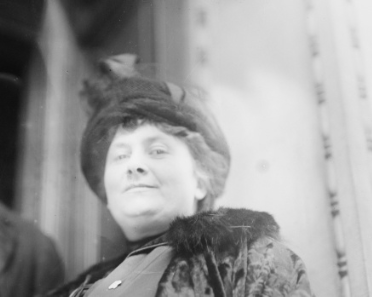
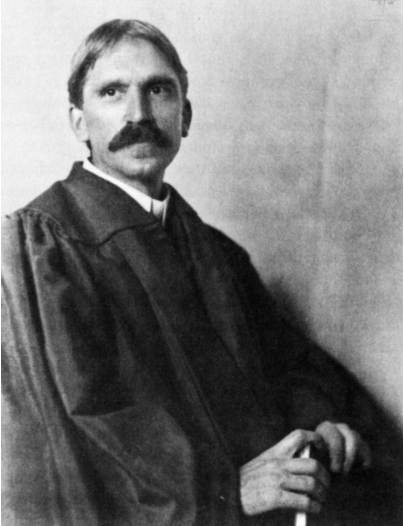
Sometimes, educational progressivists such as Dewey went so far as to suggest that better schools could influence the creation of a better world, a world of creative workers, active citizens and responsible personalities. This was called ‘social reconstruction- ism’ because it envisaged an active role for education in building a new society.
See Early Progressive Education.
The twentieth century, however, soon put an end to any such optimism. Its social convulsions threw up a succession of horrors: two world wars; the communism/capitalism divide; economic recessions and depressions; and barbarous holocausts. The waters of progressivism and social reconstructionism seemed forever muddied by other political and moral agendas. The result was that, over the course of that painful century, not as much changed in education as the progressivists and reconstructionists may have hoped in their more optimistic moments (Cuban 1993).
The term ‘progressivism’, although widely used, is not in itself a useful descriptor of what this kind of education is and does. It simply implies that it represents progress beyond the more traditional forms of education that it was attempting to supersede. The term has little semantic value other than to reflect a judgement of improvement and superiority. ‘Authentic’ is a more useful descriptor for this kind of education, of what it is in principle and the way it works.
Progressivist education is ‘authentic’ in several respects. It is authentic in the sense that learning is not merely abstract and formal, as are the ‘disciplines’ of didactic pedagogy. It works hard to make itself relevant to the lives of learners. It has demonstrably practical uses. It is also authentic insofar as it is learner- or child-centred, true to the interests and motivations of the learner in preference to the dictates of the teacher, syllabus and textbook. Finally, it is authentic for its focus on internalised understanding instead of just memorising things that are formally correct – knowing the processes of reasoning behind a mathematical formula, for instance, not just producing the right answer.
Returning to the eight dimensions we introduced earlier to characterise didactic education, this is what authentic education looks like.
Dimension 1: Architectonic
Typically, the physical spaces in which authentic learning takes place are modifications of the classrooms of the didactic regime, with a less fixed placement of desks, and a less formal classroom configuration. Teachers may open up classroom space to allow for movement and student interaction. They might replace desks with tables to allow more student activity. If the tables are clustered and learners face each other, they might work in groups. In some classrooms, and particularly for younger learners, the space may be divided into different functional or resource areas located around the room. Children’s work might be used to decorate the walls – a celebration of the efforts of students and their central presence in the life of the classroom. However, the size and shape of the classroom rarely change and the overall arrangement is still roughly one teacher to thirty students. Children may also get out of the classroom to some degree, on excursions and for outdoor activities, but the centre of activity is mostly grounded in the classroom itself.
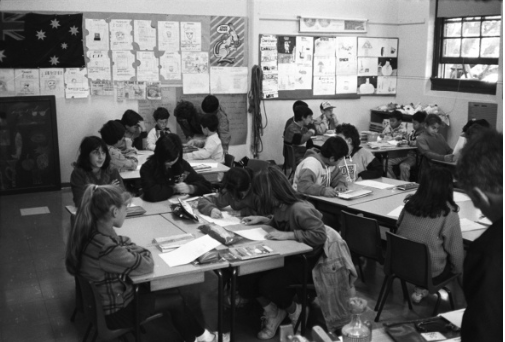
Dimension 2: Discursive
The arrangement of the room allows for more student dialogue, but within the practical bounds of the classroom. Small groups may talk as they work among themselves. This had been discouraged in the design of the traditional classroom of didactic education. Some use of vernacular language is allowed and attempts are made to teach both mother tongues of native speakers and the official language of the school and the wider society.
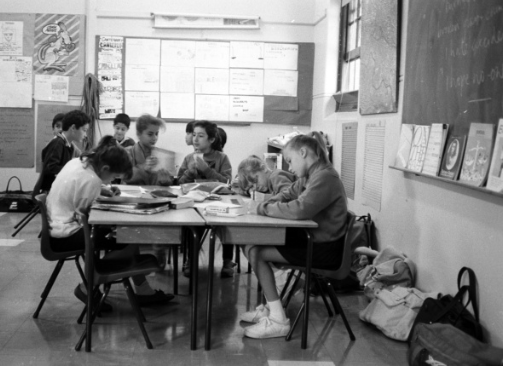
Dimension 3: Intersubjective
More opportunities are created in which students are allowed to be themselves. This is a child-centred environment, in which active engagement with knowledge is encouraged, with ‘inquiry learning’, experimentation, problem solving and other learner-centred activities. Students’ opinions and points of view are solicited. Activity outputs often consist of complex, student-designed objects, such as ‘projects’ or ‘assignments’. Now the teacher is more a facilitator of student learning. There is increased recognition of cultural and social diversity and the effects learner differences have on wellbeing and learning outcomes. Some traditional punishments, such as corporal punishment, are abandoned or made illegal. However, traditional systems of reward often remain, in the form of assessment regimes.
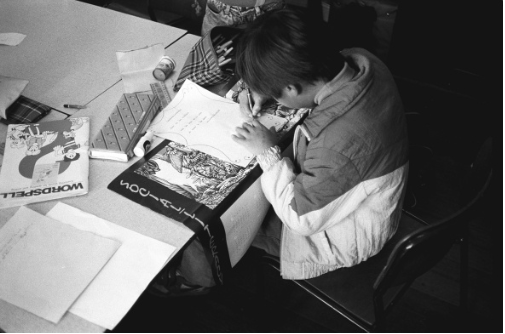
Dimension 4: Socio-cultural
There is growing acknowledgement of student differences, with some self-paced and individualised learning taking place. In the first instance, however, such individualisation is mostly designed along the dimension of ‘ability’ or psychologically defined ‘stages of development’. Cultural, gender and other differences are subsumed, and appear to be factors that create an educational ‘deficit’ for some students. The school can try to ‘make up’ for these deficits by creating and offering special, remedial pro- grams that help initiate outsiders or those not performing to the standards of main- stream curriculum. This is done in order to initiate them into a common culture of learning and, via this route, into the broader mainstream of society. Alternatively, there might be a limited move towards a recognition of differences, along the lines of a superficial multiculturalism, which, in the case of ethnic diversity, for instance, celebrates national days or gets students to do country studies as an add-on to the main- stream curriculum. Such gestures to student differences, however, are constrained by classroom architecture and timetable demands. Practically speaking, having to teach this particular subject at this particular time, one teacher to thirty students, requires a degree of uniformity. This means that there are still pressures towards sameness, although these are mostly more subtle than they were before – underlying assumptions in the learning content and the best ways to learn that content.
Dimension 5: Proprietary
The classroom of authentic education is opened up in a partial redistribution of the ownership of knowledge and control of space. Students get involved in some group work. This, however, is not the primary form of work, nor the work that is valued when determining ‘results’. The teacher increasingly brings outsiders into the space of the classroom, engaging them in the learning process: other ‘team’ teachers, professional teachers’ aides, parent-helpers and community members whose knowledge or expertise is relevant to the learning. The boundaries of the class remain neatly defined, however, and the learning relationship remains one that is almost exclusively between the teacher and the thirty children.
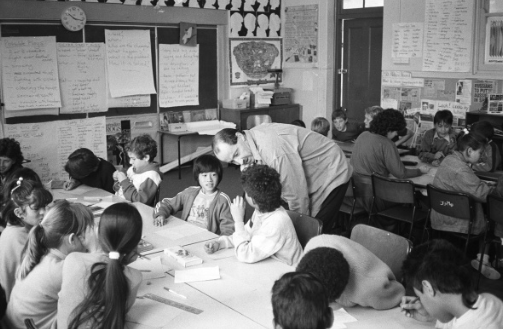
Dimension 6: Epistemological
The syllabus of authentic education is not so rigidly focused on content as didactic teaching. Rather, it speaks in terms of generalised learning outcomes in key learning areas. Textbooks are less central because they are supplemented by other things (‘real- world’ texts, discussions, experiments, excursions, problems to be solved). Where textbooks are still used, they are often written differently, providing task suggestions that promote active engagement rather than factual and theoretical ‘answers’. Although there are more images, diagrams and other forms of visual representation, written text on the printed page continues to predominate. The old timetable may still be there, slicing time and place in order to divide the discipline areas, but with some deference now to ‘integrated units’, whereby a particular topic or series of activities is tackled from multiple disciplinary perspectives. Cross-disciplinary perspectives may be added to a subject, such as ‘language across the curriculum’ in science or mathematics. In addition to the old disciplines, new areas of concern are added to the curriculum, from sex education to driver education. This creates a bewildering range of pressures on schools, either in the form of the ‘crowded curriculum’ whereby schools are now simply expected to cover too much essential ground, or the ‘shopping mall curriculum’ in which students are provided too much choice and each choice is too narrowly particular. The overall result, however, is that the sources, flows and nature of knowledge have changed. The balances of agency in the educational process have shifted, giving more scope for teachers to create curriculum relevant to their learners, and allowing that learners will be, at the very least, partial co-constructors of knowledge. This shifts the focus of education away from learning prescribed contents to the process of learning or learning how to learn (Bruner 1977). In a changing world, knowing how to know is as important as the content of knowledge itself.
Dimension 7: Pedagogical
Learning now is more active, more experiential. The focus becomes learner inquiry rather than teacher- and textbook-transmitted knowledge. Developmental psychology tells of generic stages of ‘readiness’ in which children have the cognitive capacities to construct understandings of the world at particular levels of sophistication (Piaget 1959). A distinction is made between a true understanding and mere repetition of what one has been told. This means being able to figure things out for yourself – explaining cause, effect and logical relations – rather than learning something off by heart and coming up with the right answer.
See Rabindranath Tagore’s School at Shantiniketan.
Dimension 8: Moral
Authentic education is concerned with creating citizens who will actively participate in their social world, workers and community members who will be able to deal with a high degree of social change over their lifetimes, and persons with open, inquiring minds. The moral economy of authentic education is one that offers learners the opportunity to become members of multiple social worlds. Individual choice and self-realisation emerge as dominant themes. These are the ideals of a certain kind of liberal-democratic, 20th-century modernity.
See Kohn on Progressive Education.
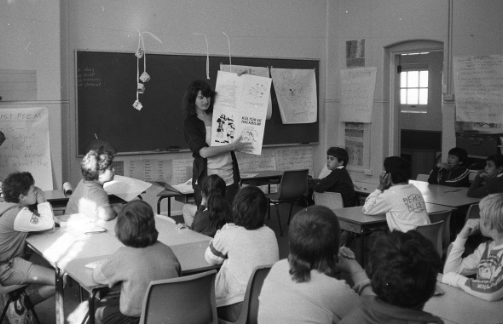
The legacies of authentic education
At the beginning of the 21st century, it may well be that there are a larger number of classrooms in the world still cast in the mould of didactic education than there are classrooms whose educational processes could be described as ‘authentic’. However, the influences of authentic education have been enormous. Broad generalisations will always be proven rash by obvious counter examples, but as a general rule it would be true to say that the shift from didactic to authentic education has been more pronounced in the kindergarten and primary or elementary years than in high schools, in the humanities more than mathematics and the sciences, in affluent schools more than poorer schools, in the developed world more than the developing world. These generalisations are also confused by a more complex reality in which one program in a school will operate with a predominantly didactic orientation to education and another with a more authentic orientation, or one teacher compared to another, or even one teacher in one moment of teaching compared to the same teacher in another moment.
How do we evaluate authentic by way of comparison with didactic education? Whatever its superiority over didactic education that might be claimed by its progressivist supporters, authentic education has its own intrinsic limitations, whether in its turn-of-the-20th-century form or its contemporary forms, such as more recent ‘constructivist’ approaches to education, which we will discuss in Chapter 8.
‘Authentic to what?’ one might ask as an initial question. To this, progressivism might reply, ‘Whatever is immediately needed and useful.’ Whatever teachers negotiate with learners and whatever communities might seem to need or think they need. Something new or the same old stuff if teachers and parents have warm memories from their own school days of spelling lists and times tables and stories of nationalistic heroism. And if it’s something new, it might be carefully differentiated curricula for different kinds of learners, Shakespeare in the subject English for those who might become doctors and lawyers, and ‘Communication Skills’ for those who are going to become somebody’s clerical assistant and who may need to be taught how to write a half-reasonable curriculum vitae. ‘Communication Skills’ sounds good and is doubtless ‘relevant’, but the kids know what being placed in this course really means when they call it, in tones of publicly unspeakable contempt, ‘veggie English’ (Kalantzis et al. 1991). In cases such as this, authentic education could, despite its best intentions, mean streaming society in new and more subtle ways in the name of relevance. The ‘democratic’ of this kind of democratic schooling can easily translate into a kind of populism, a series of seemingly democratic moves that have the effect of keeping the social order just the way it is, unfairly unequal. If and when this is the case, authentic education takes a course that, in the final analysis, stays true to the cultural logic of an unequal society. It doesn’t enable learners by producing different social outcomes for them, and it doesn’t do anything to the world other than reflect the way it is. It represents a view of the world that is ultimately agnostic, neutral, disengaged. It’s just a somewhat kinder, gentler way of achieving unequal social outcomes, compared to didactic education.
To which the proponents of didactic pedagogy might retort that they have more to offer – the rigorous, hard stuff of traditional education that will teach you the ‘basics’ you need to get you the marks you need to succeed.
